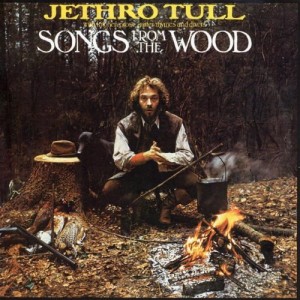 Songs From The Wood was released in February 1977, after Jethro Tull had avoided doing major concert tours for almost two years, and Ian Anderson had moved from the city to the countryside, which allowed him to indulge his interest in the more traditional forms of British music. Actually, Jethro Tull has always had an abiding affection for all things rural. Indeed their name is that of a countryman who was well-known in his day.
Songs From The Wood was released in February 1977, after Jethro Tull had avoided doing major concert tours for almost two years, and Ian Anderson had moved from the city to the countryside, which allowed him to indulge his interest in the more traditional forms of British music. Actually, Jethro Tull has always had an abiding affection for all things rural. Indeed their name is that of a countryman who was well-known in his day.
As Ian explains in a 1989 ‘Up Close’ radio interview:
I was not the author of the Jethro Tull name. The original Jethro Tull was an 18th century agriculturalist . . . he was also something of an inventor. He invented the seed drill. He built his first prototype seed drill from the foot pedals of his local church organ . . . when it was suggested as one of our weekly names for our band in its early days by our agent we said ‘ok, we’ll be Jethro Tull this week.’ The reason for all that was that we were not a terribly good group when we first started, and the only way we could get re-booked into the clubs we played at was to pretend to be somebody different every week . . . often we didn’t know who we were — the agent forgot to tell us — so we would arrive at some club, and we’d look down the list of bands playing . . . whichever one we’d never heard of before, we knew that must be us. The time we got asked back to the Marquee club we had to stick with the name we had that week, which happened to be Jethro Tull. It’s not a name I feel particularly wonderful about. I feel faintly embarrassed about it because it’s not an original name. It’s somebody else’s name.
Songs From The Wood finds Anderson’s songwriting skills to be at their very sharpest. It is one of several song cycles that Jethro Tull would do, and is certainly the most detailed. It covers — like James Joyce’s Ulysses — a day in the life of its protagonist. Yet, unlike Leopold Bloom who wanders the streets of Dublin, our unnamed narrator is a man of the country. Now, this is not your typical countryside, as our narrator will encounter green men, a huntress who may or may not be the leader of a Wild Hunt, druids, mad whistlers, and maidens who are certainly no longer chaste by the time the song ends. Ian is indulging his interest in folk motifs in a very serious manner.
While Songs From The Wood is ripe with folk motifs, it is not folk music — it is as modern as Ian himself. Yet, despite the use of both electric guitar and a full drum kit, it is not rock music. It is an intricate composite of both folk and rock and perhaps more than a drop of not-so-gentle madness. As Anderson has said of Songs From The Wood, ‘It’s a response to the music — that droning quality — of Celtic music. It’s something special. One can’t really pin down what. It has to be some kind of folk memory.’
The 2003 remastered CD also has ‘Beltane’ and a live version of ‘Velvet Green’.
(Chrysalis, 1977)
